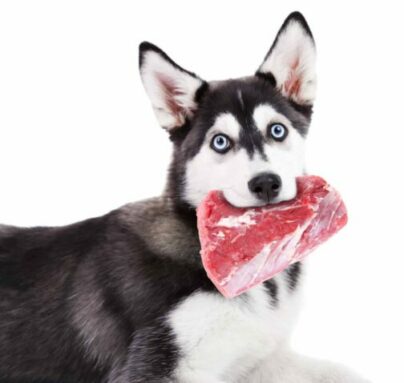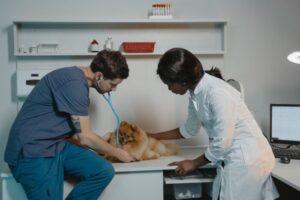Can Dogs Eat Steak and Steak Bones?
Most dogs can enjoy unseasoned, raw grass-fed steak and large raw steak bones – under supervision. For dogs with cancer or serious digestive disorders, cooked boneless steak or bone broth may be easier to digest. Never give dogs cooked leftover steak bones; sharp pieces of bone can cause internal bleeding.
Raw steak is a nutritious choice for dogs, as a complete meal or as an occasional treat. For larger dogs, ripping apart a raw steak and gnawing on raw meaty bones provide mental stimulation and can also help clean teeth. Smaller dogs or those with poor dental health may need raw steak cut up into smaller pieces. For dogs with serious illnesses like cancer, consider lightly cooking steak, but never give your dog a cooked bone (including chicken bones and pork bones). Steak and steak bones also make a fantastic bone broth for healthy joints, gut and skin – excellent nutrition for senior dogs and dogs recovering from illness.
Is Steak Good for Dogs?
Steak is great source of protein and nutrients for dogs. Steak is free of carbohydrates and sugar and contains good amounts of protein (approximately 79%) and fat (approximately 21%). Dogs rely on nutrients found in steak, such as:
- Protein – builds muscles, repairs wounds, supports immune system and maintains healthy joints
- B Vitamins – helps regulate metabolism, hormones, immune and nervous system
- Zinc – supports wound healing, thyroid health
- Selenium – antioxidant and thyroid health
- Fat – supports energy, healthy skin and fur, provides insulation
Fat Facts
- Steak is high in saturated fats, but not in healthy fatty acids
- Steak isn’t a complete source of the essential healthy fatty acids that dogs require for optimal health
- Too much steak fat can be hard for dogs to digest – especially those prone to pancreatitis
- Industrial toxins like dioxins accumulate in animal fat and can lead to serious disease in dogs and people who consume animal fat
- Steak contains about 78 mg of cholesterol per 100 grams of meat
Is Cholesterol in Steak Bad for Dogs?
Some people claim that dietary cholesterol can cause heart disease in dogs. This is not true.
High cholesterol does not have the same causes or effects on dogs as it does with people. Cholesterol can come from a dog’s diet but it’s also made in their body or increased by certain medications. Dogs with high cholesterol levels are more likely to develop stomach, pancreas or skin symptoms or potentially eye-related diseases – not heart disease or strokes. So, unless your Holistic or Conventional Vet has identified cholesterol as a problem, you don’t need to hold back your dog from steak once in a while.
Should I Give My Dog Raw or Cooked Steak?
Raw steak contains enzymes and nutrients that cooking destroys, so is arguably the healthiest way to serve this meat protein to dogs. However, dogs with serious illness or digestive problems may benefit from lightly cooked steak to ease the energy load required to digest raw meats. Never give dogs cooked bones of any kind.
Can Raw Steak Give My Dog Salmonella Poisoning?
Although raw steak can harbour bacteria such as salmonella or e.coli, a dog’s naturally acidic stomach environment is quite efficient at neutralizing potentially harmful bacteria. Dogs who are used to a raw food diet have the most acidic (lowest pH) stomach environments, making them the most efficient at killing microorganisms like salmonella and e.coli.
Raw-Fed Dogs May Be Better at Neutralizing Bacteria
Dogs fed processed kibble (typically with lower protein, higher carbohydrates and fillers) will adjust their pH levels and digestive processes, making them less efficient or “lazier” at digesting raw and real food. When raw or whole foods are introduced to kibble-fed dogs, it can lead to some temporary digestive upset, which causes some pet parents and vets to claim raw meat is unhealthy for dogs. This is unfortunate, because it’s actually a sign that we are weakening our dog’s naturally strong digestion by giving them processed “food” products.
Studies of raw fed dogs differ as to the amount and implications of salmonella present in dog feces. Some have actually found more salmonella present in kibble-fed dogs than raw-fed ones. The debate and decision boils down to your dog’s overall health, digestion and immunity.
Beef from healthy, grass-fed cows have less bacteria than meat from CAFO cows.
Although healthy dogs easily neutralize salmonella, this bacteria can be harmful to dogs whose immunity is compromised and for those with serious illness such as cancer or significant gastrointestinal problems. Several studies have indicated that salmonella can survive indefinitely even in frozen meat, so cooking is the only way to kill any salmonella lingering on fresh or frozen steaks. So if your dog has a serious illness, cooked steak is the best option that still offers good nutrition.
How to Give your Dog Raw Steak
- Choose a pasture-raised steak with a large bone (or boneless)
- Trim excess fat
- Depending on the size of your dog, offer him the whole steak as a meal or cut the steak into small bite-sized pieces and give him the appropriate amount. Always supervise your dog.
- Add steamed, diced vegetables, healthy fats and a little organic fruit and non-GMO grains to complete his meal
Raw Steak Bones
Raw bones from a cow are larger and more dense than turkey, chicken or salmon bones so the risk for choking is reduced. Steak bones must be large enough to promote a good chew and not risk breaking apart or being swallowed whole. Steak bones can also make a great teeth-cleaning treat.
Best Bones for Dogs
Choose raw, large bones from pasture-raised cows with no added hormones or antibiotics, such as:
- T-bones
- Beef rib bones
- Shin/Tibia/Foreshank bones (often contain remnants of tendon and meat)
- Knuckle bones
- Femur bones (check that the rounded ends aren’t chewed off and swallowed whole)
- Marrow bones (soft, hollow bones that contain connective tissue like cartilage)
How to Give your Dog Raw Bones
- Always supervise your dog when chewing a raw bone, due to the risk of choking, intestinal blockage or injuries from bone splinters
- Buy bones from a local butcher who can cut dog bones according to your dog’s needs/size
- Choose raw bones that are softer than your dog’s teeth to prevent teeth damage
- Choose bones that are larger than your dog’s mouth/jaw so he cannot swallow it whole
- If your dog is a very aggressive chewer, raw bones may damage teeth
- If the bone splinters or breaks apart, take away the bone
- Bone marrow is very high in fat, so raw bones should not be a regular treat for dogs with pancreatitis or digestive disorders
- If the raw bone is still intact after a good 15-20 minute chew, put it in the refrigerator to stay fresh for another day. Throw out bones after 3-4 days
- Give dogs raw bones outdoors or in an indoor space that can be cleaned from possible bacterial contamination
Dogs that are strictly fed kibble (processed food products) may be less efficient at digesting raw bones. Suddenly giving a kibble-fed dog a raw steak bone can lead to tummy upset. If your dog isn’t used to raw food, start with a small amount of raw steak daily for 7-10 days to help tune up your dog’s digestion to enjoy the benefits of a raw diet – and the occasional raw steak bone.
Ground Steak Bones
Many producers of raw foods for dogs include ground bones in their meals so that dogs get the vitamins and minerals from raw bones without the choking hazard. You can also ask your local butcher to grind raw bones.
How to Give Your Dog Cooked Steak
If you prefer to cook your dog’s steak, start with a good quality, grass-fed steak without added hormones or antibiotics. Remove excess fat and ensure there is no salt, other spices, rubs or sauces on the meat. Remove the bone either before or after cooking.
Grill, Bake or Fry
- Grill, bake or fry steak using healthy oil such as coconut or olive if needed
- Cut into bite-sized pieces or shred it over their regular meals
- Add steamed, diced vegetables and a little organic fruit (our dogs love apples) or non-GMO grains to complete his meal
- Ensure meat is cooled so as not to burn eager tongues
If your dog is used to eating processed food products (kibble):
- Please consider making the move to a fresh, whole foods diet of grass-fed meats and clean vegetables. There really is no substitute for real food with all the healing vitamins, enzymes and minerals they offer
- Cook the steak by grilling or baking, or fry using healthy oil such as coconut or olive
- Cut into small pieces or shred it over their regular meals
- Offer small amounts
- Ensure meat is cool so as not to burn eager tongues
Watch your fur soul enjoy his meal!
Don’t Give Dogs Cooked Steak Bones
Never give a dog cooked bones. Period. Even if bones are lightly cooked (e.g. a rare T-bone steak), they can still break apart, splinter and lead to significant injuries or choking.
Make Heathy Bone Broth
Got leftover steak or T-bones with some juicy meat on them? Make this super-food for your dog to keep inflammation down, support healthy digestion and add collagen to sore joints and irritated skin:
- Place leftover T-bones or other cuts of beef and beef bones in a pot with filtered water and a little apple cider vinegar. Simmer for 12-24 hours and you have a broth that pulls all sorts of healthy minerals and nutrients from the bones! The result provides a collagen-rich broth that is delicious and incredibly nutritious for joints, skin and digestion.
- Need a recipe? Check out one of our favourite home made bone broth recipes.
- Make sure you start with organic, grass-fed beef to keep toxins out of this healthy brew.
- Add a tablespoon or a bit more to meals
Undecided About Raw versus Cooked Steak?
Cooked steak may be a better choice for dogs used to processed kibble, or those that have serious health conditions like cancer.
If you’re still undecided about raw versus cooked steak though, it may be reassuring to know that grass-fed organic steaks come from healthier cows, so the risk of harmful bacteria that a sick cow might carry is further reduced. One study tested the amount of bacteria found in conventional (CAFO) beef versus organic, grass-fed beef and found that 80% of conventional CAFO beef contained at least two types of bacteria – significantly more than in grass-fed beef.
Unsure about the best diet for your Fur Soul? Book a virtual consultation with us at Healing Fur Souls.
What’s In Your Steak?
Most fresh and frozen steaks you find in grocery stores are from cows that are raised in stressful conditions, fed an unnatural genetically modified diet and given hormones, antibiotics and medications. Make sure your dog’s diet comes from a clean, healthy source.
It’s estimated that over 70% of all antibiotics in the United States are given to animals in their food.
Concentrated Animal Feeding Operations (CAFO)
Approximately 96% of steaks you find in grocery stores or restaurants in the US comes from large-scale confined animal feeding operations (CAFOs). Animals in CAFOs are crammed together often on cement floors with no room to graze or move freely. Drinking water is often contaminated with feces, bacteria and toxic runoffs from nearby industries and CAFO meats inevitably become filled with toxins, stress hormones and medications. These high-yield “steak factories” are also known for terrible abuses toward animals.
Genetically Modified Crops
Cows are meant to graze freely and eat grass, but in CAFOs, they are forced to eat pesticide-soaked grains and genetically modified crops, like corn and soy. This leads to nutrient deficiencies (K2, B1, B2, B12), and disease – for which cows are given pounds of antibiotics, leading to further health issues (and antibiotic resistance). Is this what you want your dog (or you) eating?
Drugs and Hormones
Pellets that contain natural and synthetic hormones are implanted into cows to encourage rapid growth and fat accumulation. Due to the poor health of CAFO animals, antibiotics, vaccinations, anti-histamines, non-steroidal anti-inflammatories and other pharmaceutical drugs are freely used to manage widespread infections and sickness. It’s estimated that over 70% of all antibiotics in the United States are given to animals in their food.
Drugs like antibiotics are metabolized in the animals’ tissues and leach into the environment through their waste. This has contributed significantly to environmental damage and the epidemic of antibiotic resistant bacteria seen in animals and humans.
Dissolving hormone pellets are inserted into CAFO cow’s ears – so don’t feed raw or smoked cow ears to dogs as a treat.
Nitrates, ammonia gas and carbon monoxide are then applied to the carcasses to cure and colour meat, and slow down the growth of bacteria.
How Do I Find a Good Quality Steak?

A growing number of conscientious people look for steak from cows that are raised to roam freely on open pastures of fresh grass, free of toxins and pesticides. Although we often use the terms “grass-fed” and “pasture-raised” interchangeably, “pasture-raised” technically means that cows are encouraged to graze freely, whereas “grass-fed” may simply mean grass is brought to cows confined in pens.
A good quality steak is one that comes from a pasture-raised cow, with no added hormones or antibiotics. Here’s why.
Grass-fed (or pasture-raised) cows produce steaks that are:
- higher in nutrients
- leaner
- typically antibiotic free
How is grass-fed healthier than CAFO steaks?:
- Grass-fed beef contains lower amounts of unhealthy monounsaturated fats than grain-fed beef
- Pasture-raised meats have more healthy omega-3 fats
- Grass-fed beef is leaner and has fewer unhealthy fats than commercially (CAFO) grown meats
- Grass- and grain-fed beef contain very similar amounts of omega-6 fatty acids, which dogs use for skin health, wound repair and metabolism
- Grass-fed beef has up to five times the amount of healthy omega-3s, which dogs need to keep inflammation down, treat heart and kidney disease, arthritis and maintain good brain health
- Grass-fed beef contains twice as much of the essential fatty acid conjugated linoleic acid (CLA) as grain-fed beef. CLA is needed by dogs for bone health, blood sugar regulation and a healthy muscle to fat ratio
Want the very best nutrition from your steaks? Buy pasture-raised, humanely treated beef from your local butcher or organic farm.
Food Energetics of Steak
All food is energy, including steak – but we aren’t talking about calories here.
Ancient medical traditions like Traditional Chinese Medicine (TCM) tell us that certain foods help nourish the body and prevent disease through balancing energetic qualities. TCM classifies food and disease by their energetic properties, such as:
- hot
- cold
- dry
- damp
- stagnant
Traditional Chinese Medicine works to prevent and treat imbalances with foods and herbs based on their energetic properties. This concept works for dogs as well as people. For example:
- Cooling foods like duck, rabbit and fish can help dogs with “hot” conditions such as allergies, inflammation and anxiety
- Warming foods like turkey, chicken and ham can help dogs who tend to have cool noses, like to snuggle in the warmth, seek the heat or have arthritis that is worsened with cold temperatures
Steak is considered a neutral energy food and is an excellent meat protein for most dogs. Salmon is also considered neutral and has health benefits for dogs. Click here to learn about feeding your dog salmon plus enjoy some free healing recipes for common dog conditions!
FAQs
Can Dogs Eat T-Bone Steak?
As long as the bone is raw, large and unseasoned, a T-bone steak bone can be good for dog’s teeth (plus the act of chewing is excellent for stressed , anxious or depressed dogs!). Get your T-bone from a grass-fed, organic source. Limit this rich treat if your dog has digestive issues or pancreatitis.
Can Puppies Eat Raw Steak Bones?
Don’t give puppies raw bones of any kind. Their teeth are too fragile and can break.
What If My Dog Swallows a Cooked Steak Bone?
Act quickly and watch your dog very carefully, as this could be a dangerous situation requiring a trip to the emergency veterinary hospital.
- Remove the bone from the dog immediately
- Check your dog’s mouth and remove any fragments of bone (lower head below his shoulders, open his mouth and allow gravity to release any remaining bone fragments. If you need to sweep his mouth carefully with your finger, be very calm and cautious as a dog in distress can bite
- Examine the bone to see if it has been damaged or broken
- Supervise your dog and watch for any signs of choking such as:
- coughing
- choking noises
- difficulty breathing
- drooling
- pacing
- pawing at their mouth or rubbing mouth/head on the ground
He may require emergency intervention such as the Heimlich manoeuvre and a veterinarian.
Is it OK to Give My Dog Steak with Spices and Seasoning?
Salt, spices, coffee grounds, marinades and bbq sauces make a steak extra delicious for humans, but don’t add them to your dog’s steak. Sodium and particular spices can cause electrolyte imbalances and possible allergic reactions. Sugar is another common ingredient your dog doesn’t need.
Be kind to all living beings. Respect the earth we share.
Links Seen in this Article:
- Unless your Holistic or Conventional Vet has identified cholesterol as a problem…
- Click here to learn about feeding your dog salmon plus enjoy some free healing recipes for common dog conditions!
- Unsure about the best diet for your Fur Soul? Book a virtual consultation with us at Healing Fur Souls.
- salmon bones
- Check out one of our favourite home made bone broth recipes.
References
Barnette, C. Hyperlipidemia. VCA Animal Hospitals.
Lawton, S. (2013). Implanting beef cattle. The University of Georgia Cooperative Extension.
Rock, A. (2015). https://www.consumerreports.org/cro/food/how-safe-is-your-ground-beef/index.htm







